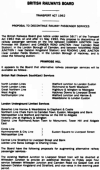Springs Branch
Established Member
I was musing over some of the "parliamentary" stations and how many stay open with absolute minimal passenger calls to avoid tricky closure proceedings. Not to mention routes like the Helsby - Ellesmere Port line which also limp along with few users & services - and which seem the first to be cancelled when crews or rolling stock are scarce - again because it's too hard to just close them.
Then I remembered Primrose Hill.
Primrose Hill station was eliminated in 1992, along with the token local service along that stretch of line - all seemingly without much fuss. At the end it had been served by just one Watford Jn / Liverpool Street train in each direction on M-F only, and even this was reportedly prone to frequent cancellations.
Unlike other London area stations which have closed in recent decades, Primrose Hill was neither replaced by a new, better alternative (think Angel Road > Meridian Waters, or Kings Cross Thameslink > St Pancras Thameslink), nor closed as part of some nearby infrastructure project (thinking North Woolwich / Silvertown > DLR and Elizabeth line, or Croxley Green & Watford West > LU Metropolitan Line extension proposal).
Being inner North London, I would have expected strident objections to any closure from vociferous local Camden / Islington activists & protestors ("Savage Tory Cuts", and all that in the language of the time - even if none of them had ever used the station).
So how did Network SouthEast manage to close Primrose Hill and that section of line to passengers, rather than bunging on some sort of parliamentary service, or a token replacement bus? For example, a once-a-day / once-a-week train running at some odd time between Willesden Junction Low Level & Stratford via Primrose Hill (bit like LO does to/from Battersea Park)
Then I remembered Primrose Hill.
Primrose Hill station was eliminated in 1992, along with the token local service along that stretch of line - all seemingly without much fuss. At the end it had been served by just one Watford Jn / Liverpool Street train in each direction on M-F only, and even this was reportedly prone to frequent cancellations.
Unlike other London area stations which have closed in recent decades, Primrose Hill was neither replaced by a new, better alternative (think Angel Road > Meridian Waters, or Kings Cross Thameslink > St Pancras Thameslink), nor closed as part of some nearby infrastructure project (thinking North Woolwich / Silvertown > DLR and Elizabeth line, or Croxley Green & Watford West > LU Metropolitan Line extension proposal).
Being inner North London, I would have expected strident objections to any closure from vociferous local Camden / Islington activists & protestors ("Savage Tory Cuts", and all that in the language of the time - even if none of them had ever used the station).
So how did Network SouthEast manage to close Primrose Hill and that section of line to passengers, rather than bunging on some sort of parliamentary service, or a token replacement bus? For example, a once-a-day / once-a-week train running at some odd time between Willesden Junction Low Level & Stratford via Primrose Hill (bit like LO does to/from Battersea Park)
- Does anyone remember what happened at the time?
- Were there actually significant objections to closure in 1992, rather than Primrose Hill just "passing away peacefully in its sleep", as my memory suggests?
- Is it easier to shut stations within London than elsewhere in the country? - e.g. because inner London is more likely have decent alternative options close by.



